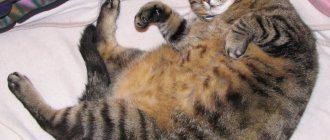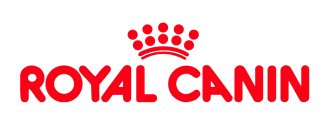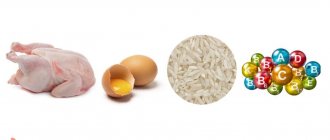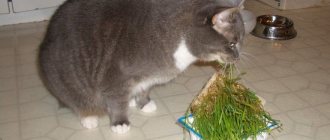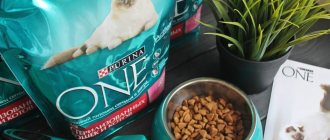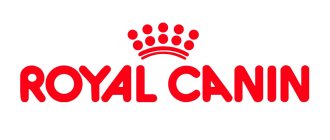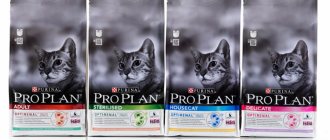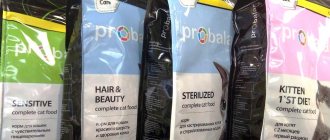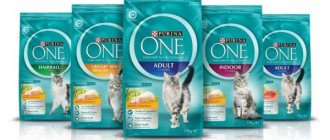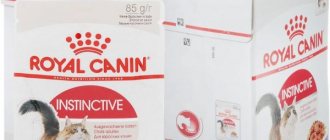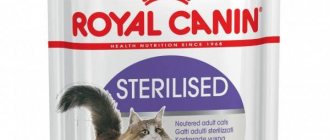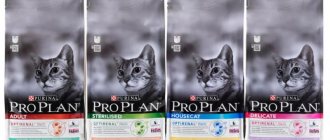Pro Plan cat food is quite well known. Its manufacturer is the American company Purina. It has an official website proplan.ru, which presents all types of products, their descriptions, recommendations for use, advice from veterinarians, specialist advice, etc. In addition to this product, the company has developed other types of food for cats and dogs; they belong to the economy class.
general characteristics
ProPlan food is a brand. Available in several versions: dry - in different packaging weights, wet - in small bags and cans. You can purchase it not only in specialized stores, but also in ordinary ones. Manufactured in factories in France, Italy and Russia.
Several types are available:
- For daily consumption.
- For regular use with special properties: hypoallergenic (HA ST Hypoallergenic), with gastrointestinal diseases (EN ST/OX Gastrointestianal), overweight (OM ST/Oxobesity Management), Delicate for chronic diseases and Derma for sensitive skin .
- For treatment and diet. Use as recommended by a doctor.
The food is created for all age categories:
- Junior (Junior) - kittens.
- Adult - for adult animals up to 7 years old.
- Adult 7+ - for older pets. Contains prebiotics necessary to increase life expectancy.
- Sterilised (Sterilized) - for cats and female cats after castration or sterilization. Available in versions for both adults and seniors.
Class
Proplan is classified as premium. It has increased the percentage composition of meat products by 20-30% and reduced by-products. The content of cereals is high, in particular rice and corn flour (this is a big minus).
From the author: if Pro Plan dry food can still be classified as a premium class, although there are options in this category of better quality (in particular, without corn) and at a lower price (for example, Carmi, Probalance, Brit), then I would rather classify wet food as to the economy, although they contain more vitamins. Why? Let's compare the compositions of the two foods:
- Whiskas jelly with turkey and vegetables: meat and offal (including turkey at least 4%), vegetables (carrots at least 4%), cereals, taurine, vitamins, minerals.
- Pro Plan pieces in jelly for adult cats with turkey: meat and meat products (including turkey 4%), fish and fish products, minerals, sugars, vitamins.
On the plus side: there are no grains in the Pro Plan, but there are no vegetables either, but cats still need them. The first components, as we see, are identical, and there is only 4% turkey, which is not enough and looks like economy. The rest of the compositions are also very similar. By the way, many Pro Plan wet foods contain vegetable protein extracts in second place; it is not entirely clear what is hidden behind this word.
Advantages and disadvantages
The benefits include:
- A large assortment. You can choose for any age and weight of the animal. There are types both medicinal and for regular nutrition.
- Widely spread. Sold in many stores.
- Good quality. Made only from high quality ingredients with vitamins and minerals.
- Various tastes. You can always find what suits your particular cat best.
- Various shapes. In addition to dry food, they produce wet food and canned food.
- Highly appreciated by veterinarians. Test results confirmed that the food is suitable for daily use.
There are the following disadvantages:
- The benefits of some ingredients are unclear. You need to carefully study the composition so as not to harm the health of the animal.
- Contains components that can cause an allergic reaction.
- There are no recommendations for which breeds to use, so the condition of the coat may deteriorate in some of them.
- Overpriced compared to other foods in this class.
Reviews
The expert's review of the Proplan line was given after pet owners, whose opinions were divided, spoke about it. Some pointed out that the food was not suitable for the pet, while others, on the contrary, said that it was good food.
The expert agreed that the nutritional components are not ideally selected and may cause different reactions in cats or be individually intolerable.
The composition of the feed makes them premium quality products. Thanks to the wide range and variety of flavors, you can choose Pro Plan food for the most picky pet.
Feed range
The composition was developed by scientists, so they contain all the necessary components for the health of cats throughout their life. The range allows you to maintain optimal weight and strengthen all organs of animals. All dry food contains about 17 ingredients without indicating their percentage, except for the main one:
- 3 points relate to animal proteins, which is quite good;
- 5 points are cereals or their derivatives;
- fats of animal and fish origin;
- vitamins;
- egg powder;
- rice;
- corn.
The diet for adults over 7 years of age and kittens does not contain corn, and Elegant Adult does not contain rice.
| Name | Main component | % content | Additional components in addition to those listed above | |
| Sterilized | Salmon | 20 | Dietary fiber, amino acids, yeast, corn, preservatives. | – |
| Rabbit | 4 | – | ||
| Chicken | 20 | Dry chicory root. | ||
| Turkey | 20 | – | ||
| Sterilized 7+ | 14 | Soy flour and oil, dried chicory root. | ||
| Original Kitten | Chicken | 20 | Colostrum 0.1%. | |
| Original Adult | 21 | Dry chicory root. | ||
| Salmon | 18 | |||
| Original Senior 7+ | 18 | Soybean oil. | Dry beet pulp. | |
| 19 | – | Dry chicory root. | ||
| Turkey | 20 | |||
| Dental Plus | Chicken | 21 | ||
| Housecat | 20 | Dry beet pulp. | ||
| Light | Turkey | 16 | Amino acids. | |
| Elegant Adult | Salmon | 15 | ||
| Delicate | Lamb | 17 | Concentrated pea protein. | – |
| Turkey | 18 | |||
| Delicate Junior | 17 | Dried chicory root. | ||
Treats and wet food for cats
Wet or liquid food PRO-PLAN NUTRISAVOUR is prepared in several forms: jelly, sauce, pate. Combining dry and wet options in the diet provides variety. In this case, the cat receives all the elements it needs for healthy and normal development.
The manufacturer does not produce special delicacies, but there are delicious pates. To feed throughout the day, you need several of these jars, which are expensive, so owners use them as a supplement to their daily food.
Composition of treats and wet food for cats
Approximate ingredients: meat, fish, plant components, minerals, oils and proteins from plants, vitamins, antioxidants, thickeners, dyes. The composition may vary slightly depending on the type (for example, some types of jelly do not contain plant components).
| Name | Basic Gradient | % | Humidity | Protein | Fat | Dry | |
| Ash | Cellulose | ||||||
| IN % | |||||||
| Sauce | |||||||
| Sterilized | Duck | 4 | 78-79 | 12-13 | 3,3-4 | 2-2,4 | 0,5 |
| Beef | |||||||
| Chicken | |||||||
| Ocean fish | |||||||
| Delicate* | 0,3 | ||||||
| Lamb | |||||||
| Turkey | |||||||
| Adult | |||||||
| Junior | |||||||
| Beef | |||||||
| Adult 7+ | Duck | ||||||
| Derma Plus | Cod | 0,9 | |||||
| Housecat | Salmon | 1,1 | |||||
| Pate | |||||||
| Junior | Turkey | 4 | 78 | 12,5 | 4 | 2,4 | 0,3 |
| Light | 8 | 80 | 12 | 3,5 | 2,2 | 0,07 | |
| Delicate** | 20 | 75 | 11,5 | 8,1 | 2,7 | 0,4 | |
| Adult 7+** | Tuna | 4 | 10,2 | 9,4 | 2,8 | 0,2 | |
| Adult | Chicken | 14 | 76,5 | 12,5 | 5,5 | 3 | 0,3 |
| Sterilized | Tuna | 4 | 77 | 13 | 4,5 | 0,35 | |
| Jelly | |||||||
| Sterilized | Ocean fish | 4 | 81-82 | 9,9 | 3,3 | 2,4 -2,5 | 0,7 |
| Turkey | |||||||
| Housecat* | 9,2 | 3,4 | 1,9 | ||||
| Adult | 3,8 | 0,4 | |||||
| Junior | Chicken | 5 | 10,1 | 4,2 | |||
*Delicate sauce and Housecat jelly additionally contain Omega-3 and Omega-6 fatty acids.
**Delicate and Adult 7+ pates also contain vegetables and their products.
Veterinary ruler
All Proplan foods are designed as specialized food for every day. There are also special veterinary foods represented by the Veterinary Diets line. They are prescribed by a doctor in addition to the main treatment. They have nutritional characteristics and composition necessary for a specific disease. Available only in the form of dry food:
- HP Hepatic – in case of liver disease.
- DH ST/OX Dental Health (Dental) - promoting oral health and preventing dental diseases. Provided thanks to the large size of crispy granules designed for thorough chewing.
All options include:
- NF Renal Function (Renal Function) - for the treatment of kidney disease (chronic stage), with their pathology.
- DM ST/OX Diabetes Management (Diabetes) - to lower glucose in diabetes mellitus.
- UR ST/OX Urinary (Urinari) - ailments in the lower parts of the urinary tract and prevention of their occurrence, urolithiasis.
In addition, in two variations (dry and wet) are presented:
- EN ST/OX Gastrointestinal (Gastro Intensinal) - digestive disorder.
- OM ST/OX Obesity Management (Obesity) - the desire to reduce the weight of the pet and to comply with a mandatory diet.
If necessary, restore the cat's health by giving CN Convalescence pate. There is also a probiotic supplement Diets Fortiflora, which is used to normalize the balance of microflora.
Product release forms
The Nestle Purina PetCare company does not stop at just one thing, specializing and producing several forms of food at once.
- Dry food . The range includes eleven types of products. The food of this company is divided into several categories and groups, which will be discussed later in this article.
- Wet food . The product is produced in pouches (bags) and canned food. Both are the most popular and best-selling products among all the items presented. Manufacturers offer twenty different types. We have ranked the 15 best wet food.
Daily feed requirements
To properly feed your pet, you need not only to choose the appropriate food, taking into account all its features, but also to calculate the dosage. The package usually contains a table indicating the daily value, based on the age and weight of the animal. Super premium food contains all the necessary substances, so you need less of it than cheaper ones. The daily portion is divided into equal shares using scales or a measuring cup and given 2 times a day to adults, 3 times a day to kittens and pregnant cats.
| Weight, kg | 2 | 3 | 4 | 5 | 6 or more |
| Age | Norm in g | ||||
| Adult | – | 25 | 40 | 55 | 12 per 1 kg |
| Kitty | 35 | 50 | 70 | 85 | |
| Pregnant cat | 55 | 12 per 1 kg | |||
For older individuals, the dose is reduced. It seems that this is not enough for feeding, but increasing the norm is not recommended to avoid health problems. It is also undesirable to alternate between professional food and natural products.
If my pet won't eat dry kibble, can I soak it in water?
- It is best to consult with your veterinarian, he will answer all your questions, taking into account the characteristics of your dog.
- There are small tips that will help you determine whether you need to do this or not. They are given below:
- If your dog likes dry food, but soaked in water. Soak it for her.
- If your pet has dental problems, soaked food will help avoid pain. It is very difficult for very small puppies to chew on such hard granules. It will be easier for them to eat soaked food.
- If you know about digestive problems or have diseases of this system, then be sure to soak with water.
Cost and replacement feed
Dry food is sold in bags of 400 g, 1.5 kg, 3 and 10. Wet food is sold in bags of 85 g. The cost depends on the type chosen:
- Junior, Sterilized and almost all diet products have the same price: dry 322, 981, 1651 and 5136 rubles. according to the weight of the package.
- Adult - 292, 981 and 4991 rubles. (3 kg packaging is not available).
- Adult 7 + and Light: 400 g cost 322 rubles. and 1.5 kg respectively 981.
The price of a jar of canned food and spiders is the same for all categories and is 70 rubles.
In addition to Pro Plan food, Purina has several other cat food options, but they already belong to the cheap class. These are Felix, Friskies, Darling, Gourmet, they contain 19.6 (or less), 20% meat. In terms of price, they are slightly lower: from 60 rubles. for 300. In addition, a budget version of Cat Chow is offered, which has cereals in the first place in its composition. To replace the Pro Plan, only similar ones can be considered, i.e. feed is not lower than premium class.
general information
Purina also produces a line of food that meets these requirements. In addition to ProPlan, the same company produces lower quality Felix, Friskies and Darling, which often cause complaints from consumers and veterinarians due to their poor quality composition and the presence of harmful components. ProPlan for neutered cats is one of Purina’s premium brands, it can even be called the brand’s flagship.
Wide range of food available in pet stores
Additional information: Pro Plan is produced in three countries - France, Italy, Russia. A mark about the place of production can be found on the expiration date stamp.
There are practically no complaints about the quality of Russian-made products, unlike feed from competing companies, also made here.
Food for sterilized cats is not a marketing ploy; it is not for nothing that they are allocated to a separate category. The combination of two factors - castration and improper nutrition - causes the development of urolithiasis, and cats suffer from it more often than cats. In addition, neutered animals need a balanced diet to prevent obesity due to low activity.
Important! The cat should be given food exactly in the dosage indicated on the package, regardless of whether it is dry or wet. As directed by your veterinarian, the amount of food may be reduced during treatment.
Useful tips
In addition to the already mentioned need to adhere to the regime and the obligation for laying hens to consume only fresh produce, there are some more nuances and features that farmers should know:
- Chickens periodically shed feathers - the so-called molting. This process requires large energy costs, since it normally occurs in late autumn, against the background of vitamin deficiency. During this period, you need to pay special attention to the nutrition of laying hens and their receipt of all useful substances.
- Grass, leaves and pine needles should be collected away from highways polluted with harmful emissions.
- The quality of litter is of great importance to the performance of chickens. Too wet litter is an excellent breeding ground for harmful bacteria. It is necessary to monitor the air humidity in the chicken coop, as well as the concentration of minerals in drinking water and feed (too much salt in the diet leads to excessive water consumption and, as a result, liquid droppings and deterioration of sanitary conditions).
- Excess salt in the diet and water also negatively affects the quality of eggshells, making them brittle.
- To get a yolk of a bright, beautiful color, you need to add corn, marigold flowers and other yellow pigments of plant origin to the birds’ diet.
To summarize, it should be noted that there are three fundamental points in keeping laying hens: comfortable temperature conditions, good illumination of the chicken coop and high-quality, well-chosen food. If you follow these rather simple rules, you can achieve maximum egg production throughout the year.
What is forbidden to feed laying hens?
Owners of small family farms and household plots often consider the omnivorous nature of chickens to be a very good and beneficial quality for themselves. This bird (with the exception of some crosses, for example, the Hungarian giant and Hercules) is indeed unpretentious in nutrition as much as, for example, cattle, in particular dairy cows. However, for the healthy growth of laying hens and obtaining high-quality egg products, you need to know what foods chickens are strictly prohibited from consuming.
- milk (not digested properly due to lack of necessary enzymes and causes intestinal diseases);
- cheese, sausages, smoked fish (too fatty and salty foods);
- alcohol (chicken livers are not able to process it);
- sweets (the pancreas of laying hens does not produce enough insulin);
- green potatoes (very toxic);
- fresh white bread (swells in the intestines, it is better to give dried, ideally black);
- a large number of apples and pears (hard to digest);
- too hard food (potato peelings, watermelon peels, citrus peels, large pieces of vegetables);
- stale, fermented, sour foods;
- leftover food from the owners (usually heavily seasoned with spices and cooked in large amounts of oil, which is harmful to the digestion of laying hens).
Video: What not to feed chickens
Features of feeding in winter
The cold season is a difficult period for farmers. Short daylight hours, a decrease in the number of walks, and the lack of fresh greenery cannot but affect the productivity of laying hens. You should prepare in advance dried nettles, vitamin hay from herbs (clover, alfalfa), brooms from linden and birch leaves.
In winter, it is recommended to include in the diet rowan berries and crushed pine needles, fish and meat and bone meal, as well as pumpkin and carrots as a source of carotene, and beets (rich in nitrogen compounds). We should not forget about fermented milk products as a source of calcium. Be sure to stock up on gravel stones, which contribute to the efficient digestion of feed.
Modern industry offers various additives, which are also actively used in winter.
Find out what and how to feed laying hens correctly to help them lay eggs better.
